Many of the layouts at the show have been constructed by members of one of the Area Groups of the N Gauge Society.
James Street – South Essex Area Group
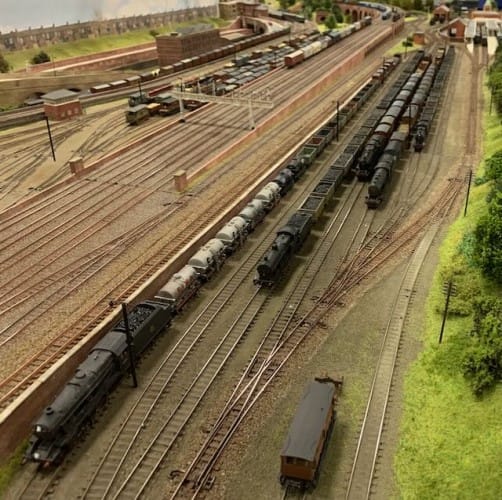
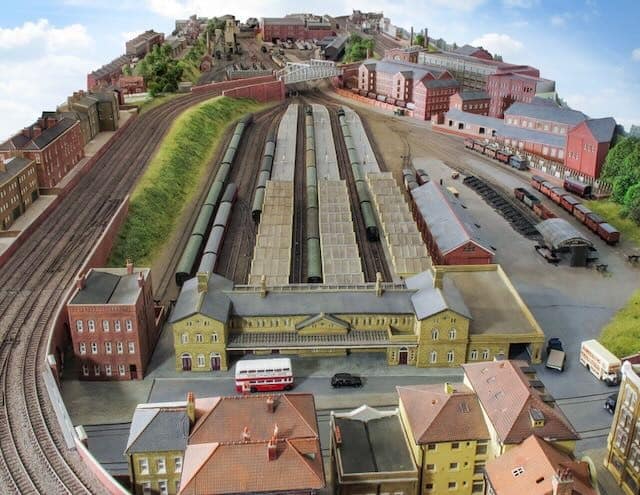
James Street, is set in the period 1955-65. It has been built by Steve Wright over the last 20 years, and shows what can be done with space and time in N gauge. Located somewhere in the Midlands, and mainly served by Midland and Eastern trains, it consists of a large terminus and dockyard coupled to a mid-level two track main line and a high level four track main line, with a single-track continuous branch line which is used to reverse trains. In between these routes are large yards for freight and passenger stock. All of the stations are named after members of Steve’s family – James Street, Lynford (Junction and Lower), Kendall and Iona.
There are no hidden sidings, so all trains can be seen at all times. There are often 8 to 12 trains running at any one-time providing lots of entertainment for both the viewing public and the operating team. There is a ruling gradient of around 1:100, resulting in most proprietary locos being able to pull 8-9 coaches or 30-40 wagons anywhere on the layout. Stock represents all that is best in N Gauge today, with a wide selection of RTR, kit and scratchbuilt items suitable for the period and location. B & B delayed action couplings are used on all rakes of stock and locos, but within rakes standard Rapido couplings are used. Wagons are normally in rakes of 5 to aid shunting.
Holgate – Bridlington Model Railway Society
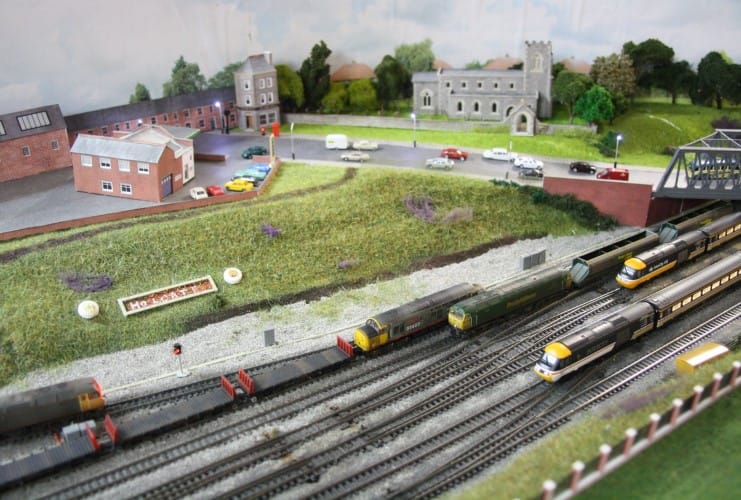
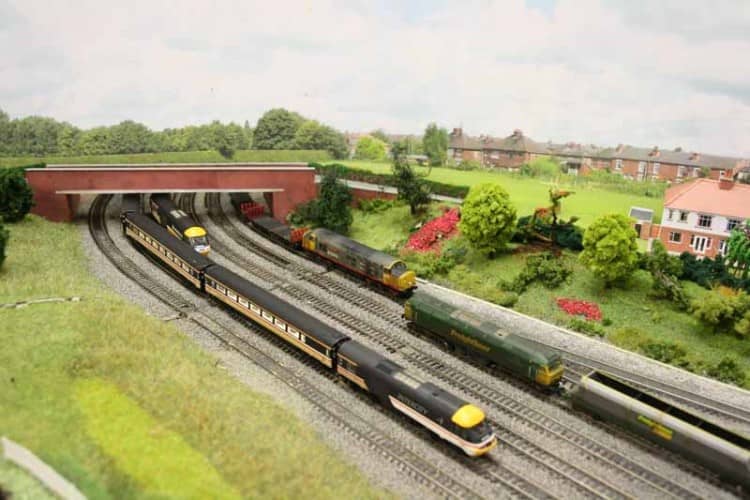
The layout is based on the area immediately to the South of York railway station, utilising the track plan as it existed prior to the line being modernised and electrified in late 1988.
Although the track plan is based on that in 1988, we do take some liberties with the stock running on the layout, otherwise known as the “Rule One Mentality”. This practise also gives us the excuse to run one or two locomotives which would never normally appear around the York area!
Some artistic licence has been used with regards to the lineside buildings and features in order to improve or enhance the satisfaction for those viewing. Although the layout has attended several exhibitions over the past year, this is actually its first appearance since a total rebuild was carried out late last year, since a few problems had been encountered with regards to trouble free running during those exhibitions.
We have also taken the opportunity to incorporate a large amount of electronic control (thanks to one of our members who is highly knowledgeable in that field) and we hope this will also improve the viewer experience.
Of course, the main feature of any layout for this area would have to be the bridge and there is a long history of attempts by one of our members to reproduce this feature – the current model being actually the fourth attempt to reproduce this feature.
Bregenbach Im Schwarzwald– Worldwide Group
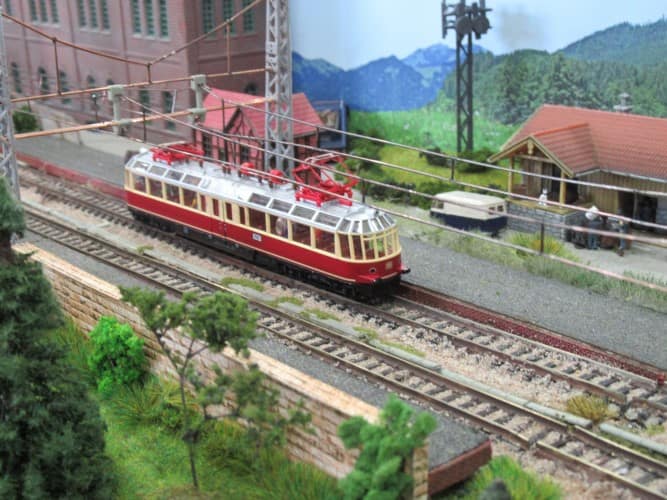
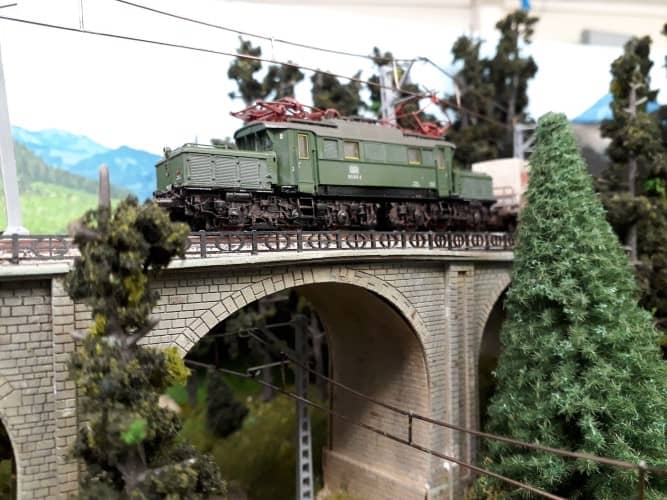
Bregenbach im Schwarzwald is a small wayside halt on a private secondary line through the Black Forest. The halt exists to serve a small brewery and is almost at the summit of the line. There was an actual railway (the Bregtalbahn) which ran from Donaueschingen to Furtwangen. This fictional history is that the line was extended over the hill from Furtwangen and down the Glottertal to Freiburg in Breisgau. Managing to remain open after World War II it was used as a guiunea pig for electrification, getting the job done on the cheap. Stock was generally DB cast-offs. The opening-up of the European freight market sees the line earning money by setting lower access charges for through freight between Freiburg and Switzerland and acting as a by-pass for the congested area around Basel. The low access charges are attractive to operators with shorter freights.
Set in the present day trains are shorts due to the 1 in 25 ruling gradient, which is less steep than the real-life Hollentalbahn two valleys further South (1 in 17). Most trains are electrically hauled, through workings by Vectron or Taurus locos of the mainline railways or contractors and local trains by the Bregtalbahn’s own vintage fleet of unrepainted locos. The passenger service is usually a double-deck push-pull set bought secondhand from DB. The brewery’s own shunter makes an occasional trip to the exchange sidings in Furtwangen.
The layout is DCC controlled using NCE Power Cabs. Locos run with their pantographs touching the overhead wires and the line is fully signalled according to German practice.
Irgendwohn Strassenbahn – Worldwide Group & YAG
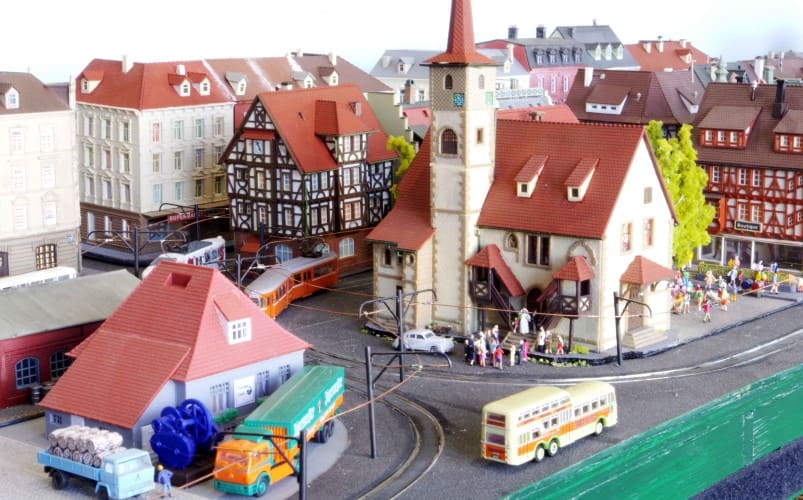
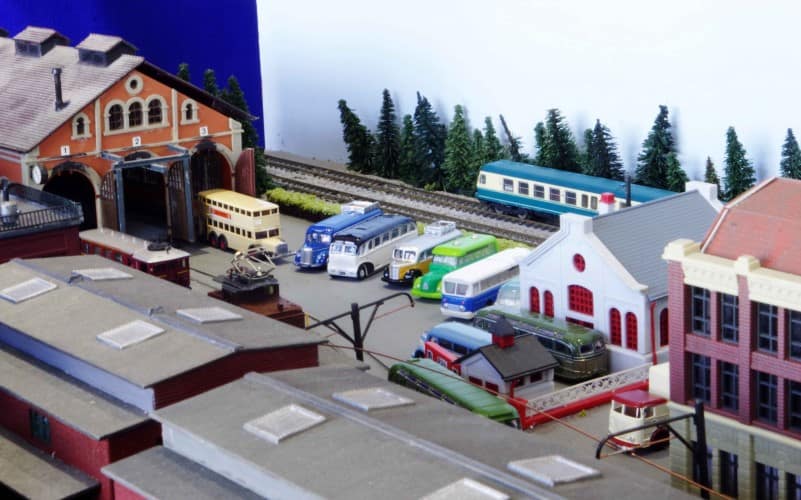
Irgendwohn Strassenbahn is set in the South West of Germany near to the Black Forest area but the main feature of this layout trams rather than trains. The town of Irgendwohn is situated typically in a glacial valley so is on fairly flat ground but the hills and mountains are never far away.
The town centre is the main focus of the layout with its trams trundling around the busy streets, through the marketplace with its bus, tram and train station. The station is served by trains from Munich and Stuttgart which are mainly of the Push-Pull variety so typical in Germany. However, rail services also run through from France, Switzerland and Austria. The town is also well served by a busy bus station with a variety of long distance and local services, including some tourist buses.
The local market is next to the bus station in the shadow of the Town Hall and just across the road from the Hauptbahnhof (main station) making it ideally situated to capture business from the commuter traffic and tourists, many of whom stay in the large hotel next to the station.
Trains continue past the large church and Christmas market before returning through the station to continue their journey. There are many cameo scenes to look for within the layout such as a bier festival with its own band, a wedding at the church, a traffic accident and an open day at the tram museum.
Millfield Yard– Yorkshire Area Group
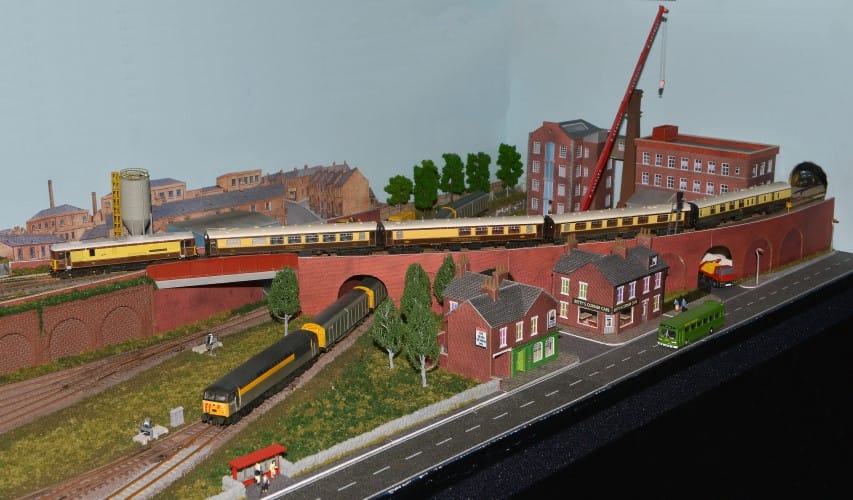
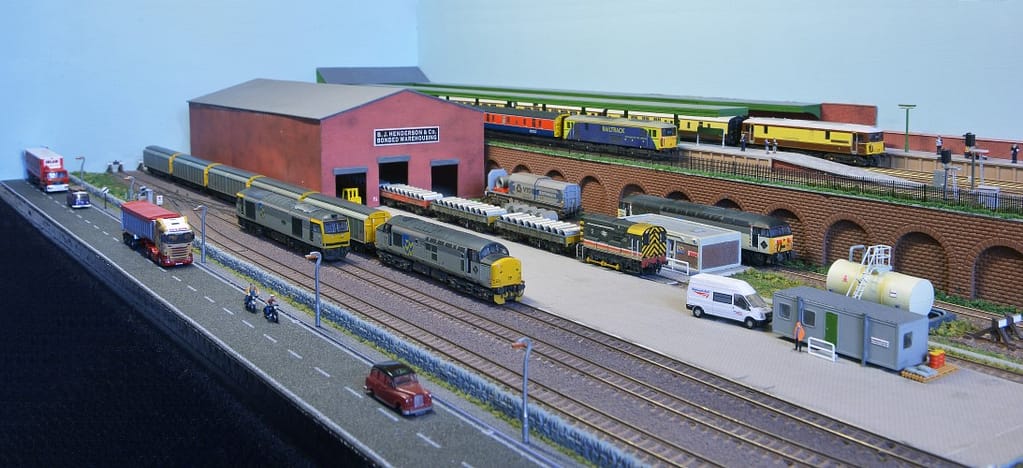
Set in period between 1990 to early privatisation which allows for a good selection of loco liveries.
The layout set somewhere on the Southern Region around London, which allows locos from any region appearing, has a station terminus on the upper level which is 3rd rail, and a freight yard on the lower level, which deals with steel traffic. 3 reception sidings receive trains which are then shunted into the warehouse.
All the track is Peco code 55 fine scale using Seep point motors operated with pushbuttons. A lot of the buildings are scatchbuild (warehouse, viaduct, station canopies) whilst some are from the Bachmann Scenecraft range and Metcalf card kits. All scatter material is from the Woodland Scenic range.
Dapol uncouplers are used; I have used some of the Dapol magnet’s which are too large, (located on the back lines) and old Farrish magnets (from locos) for the front lines. When painted and weathered with the track they are quite difficult to see.
All locos are detailed and weathered, with close coupling of all stock.
Kensington Olympia– Yorkshire Area Group
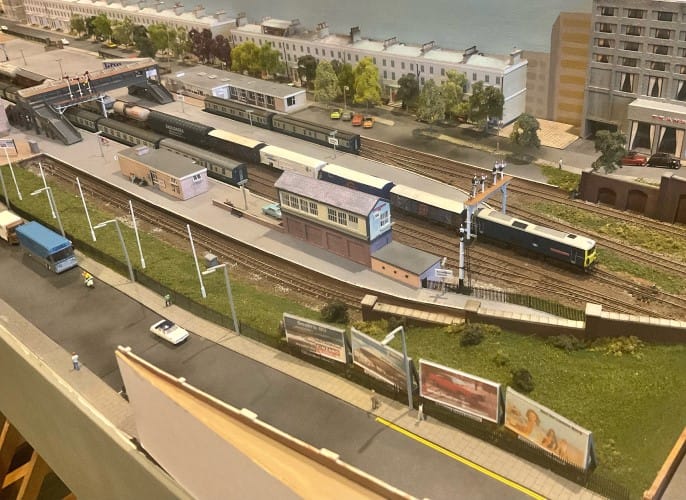
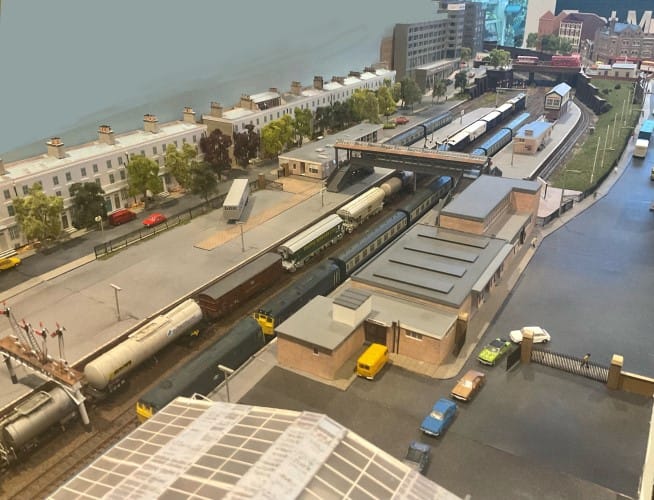
My plan to build Kensington Olympia started nearly 10 years ago. Originally built in our house loft on seven four foot by two foot baseboards, retirement and a move from Brighton to York saw the layout reduced to six boards but gain a purpose built room.
Based in 1980 the layout is a near replica of the West London line station. Motorail services are still operating along with the burgeoning Intercity service between Manchester and Brighton. The “Kenny Belle” services to Clapham Junction are also represented. There are lots of freight services such as the Acton Yard to Norwood Yardalong with international traffic bound for the train ferry at Dover. There are many scratch built items of rolling stock. Code 55 track and DCC Control keeps the layout on the move. Most of the buildings are scratch built replicas of the real buildings around Olympia.
Long Hirston– Northumberland Area Group
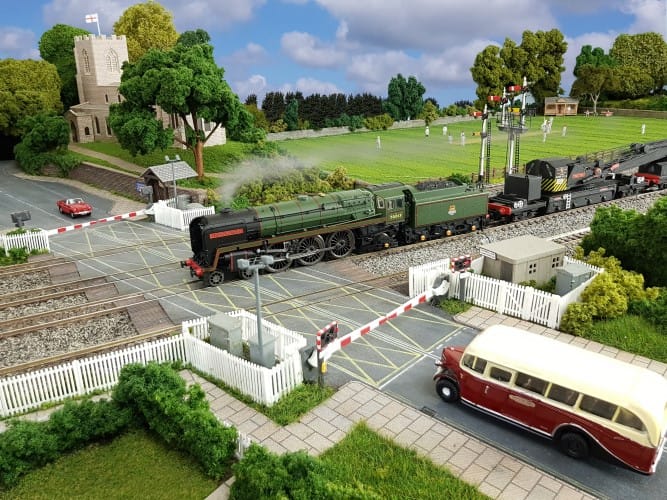
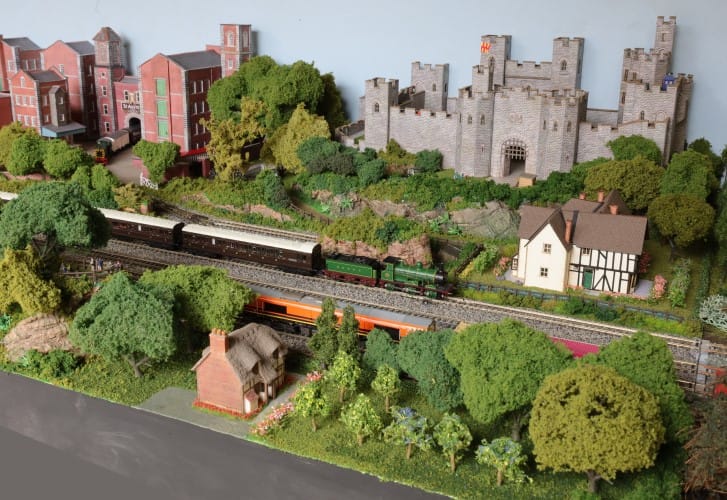
Long Hirston is a tabletop modular layout built by members of the Northumberland Area Group of the N Gauge Society. The original idea was for a flexible, simple four track tail chaser layout that could quickly be set up in our local village hall so our members could run trains at our monthly Sunday meetings. What we ended up with was far more than initially planned. The modules seem to work very well together in any combination, both technically and aesthetically. We now exhibit the layout a few times a year, mostly in the North East of England, where it has proved popular.
The boards were modelled by individual members to a theme of their own choosing. We took care to have some consistency at the board ends so the modules don’t look too incongruous next to each other.
The layout can run DCC or DC locomotives to accommodate the differing approaches taken by our members.
The layout is managed by a Raspberry Pi computer running JMRI software with operators controlling routes and locomotives using tablets and mobile phones. The fiddleyard can be partially automated to keep a variety of trains running, which spectators seem to enjoy.
At our Sunday meetings rolling stock tends to be an eclectic mix reflecting members own interests. When exhibiting we try to be more disciplined and to limit ourselves to one era and region, usually with limited success. Rule one rules!
Small N Workings – West Sussex Area Group
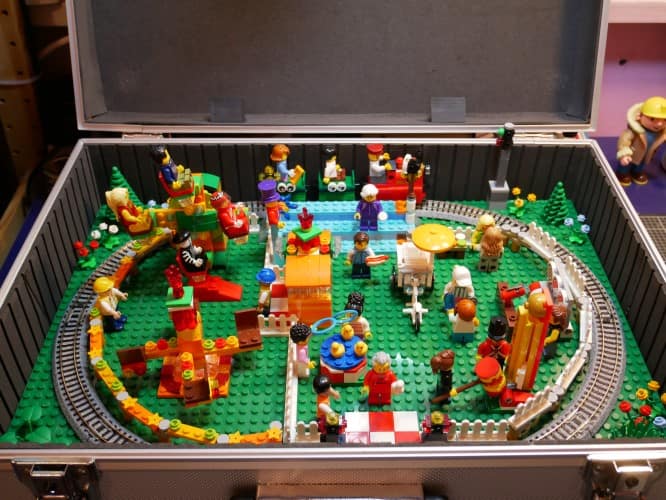
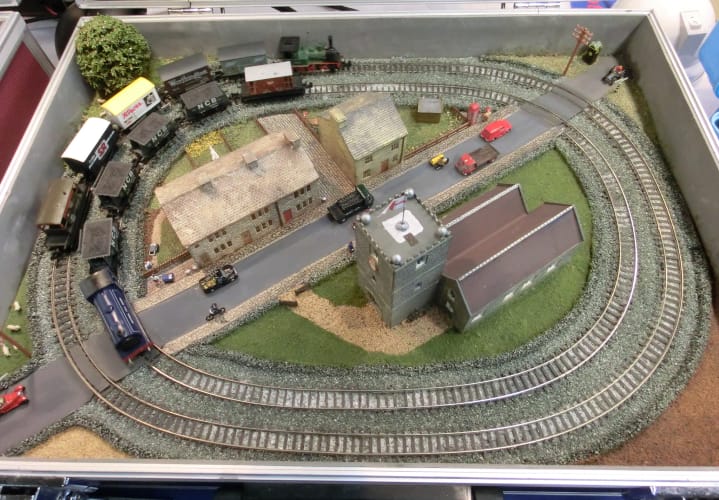
Ian specialises in creating layouts in containers such as tool boxes, briefcases, a gun case, a child’s Trunki case and CD cases. He uses traditional modelling methods plus has several layouts created using Lego. Genre’s modelled are English 1950’s and 1960’s era, modern Japanese, and his own Lego and child friendly creations.
His first small layout was “English Country Scene”, which was modelled on a fictitious village street with a Kestrel Church plus houses from the, now defunct, SD Mouldings range. Other models include “Riding School”, which has four tracks circling a central Riding School, “Nuts About Trains”, a mini layout built inside a coconut shell and some Lego layouts including “Lego Fire”, built in a child’s Fireman Trunki Case, “Lego Fairground” which includes a Merry-go-Round and a Big Wheel, and a couple of Japanese layouts which include “Japanese Village”, showcasing traditional Japanese buildings and “Japanese Freight Yard” with modern container lorries and trains.
Ian has found that children and families are interested in creating their own layouts having seen his at shows and have asked for his advice on how to start. Surely this is a way of how modellers of the future can be encouraged to start the hobby.
Not all of his layouts are attending this show and should you wish to know more please do not hesitate to ask Ian or visit his website www.smallnworking.co.uk.
Ishinaka– Worldwide Area Group
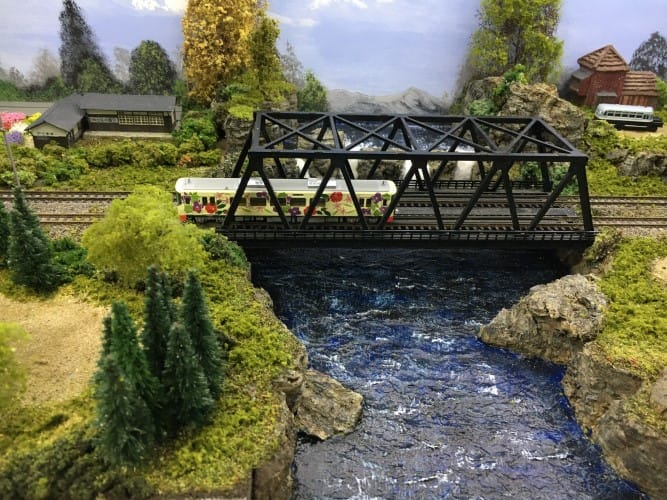
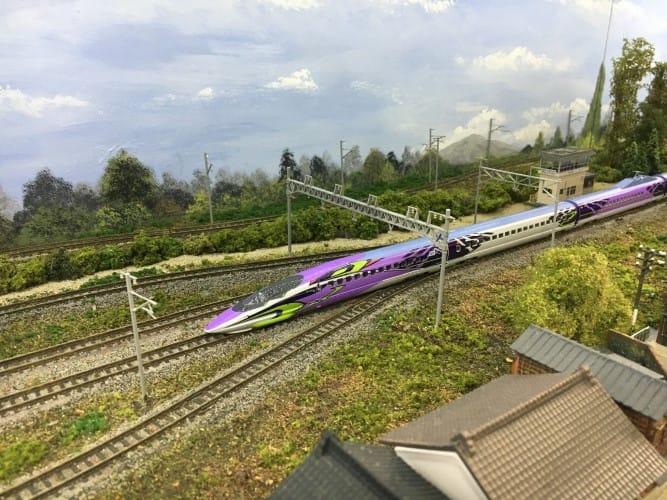
Ishinaka is an entirely fictitious layout created in Japanese n scale (1/150).
The layout depicts a terminus station in a large town which has seen a rise in tourism since the discovery of thermal spa waters. A samurai heritage village nearby also encourages visitors.
The main line and the branch enter from a fifteen road traverser which uses modified kato extender tracks for alignment and power. At the rear a tram track links the station and the samurai heritage village.
Baseboards are of the canopy type where you look into, rather than down on the layout.
Track is kato unitrack with tomix finetrack on the tramline.
Structures are mainly tomytec kits. The samurai heritage village uses resin items rescued from our very first japanese layout (katami). The green scenery is from woodland scenics. Trees are seamoss with suitable scatter. Backscene is hand painted. A slightly unusual feature is the dinosaur dig which has unearthed a large skull and leg bone. In reality, this was unearthed from my garden!
Stock is a mix of kato, tomix and micro ace items. Occasionally, visitors on tour from sodor can be seen!
Control is dc but operated wirelessly through the blue railways system.
Norm, meg, melissa, simon not forgetting arion(the horse) and phoebe (the dog) – raven miniatures
Grangeover Sands – North West of England Area Group
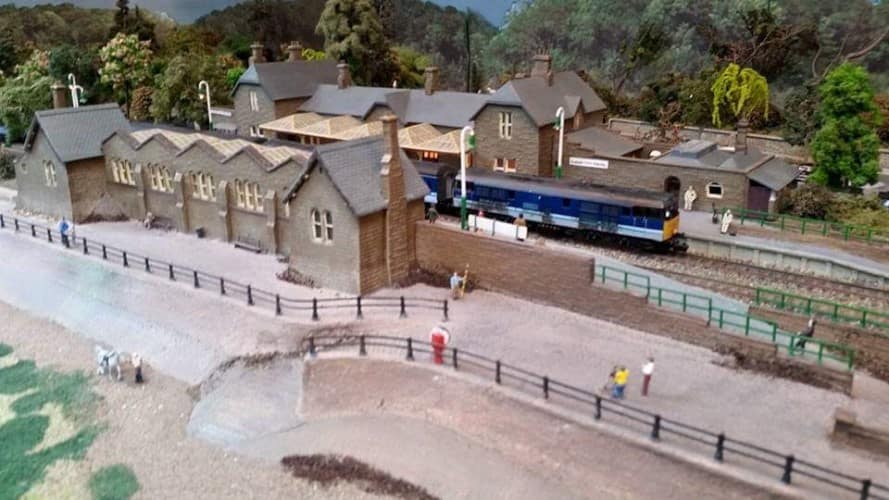
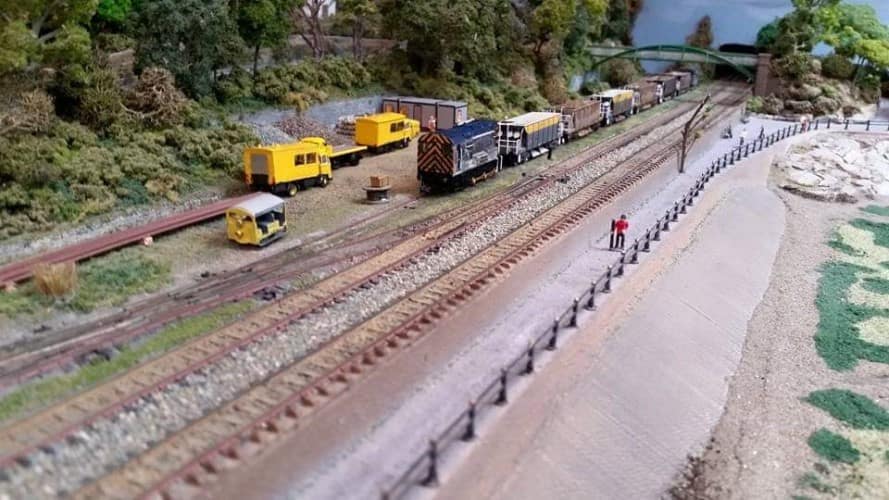
Welcome To Grange-Over-Sands. For those that don’t know this is a village on Morecambe Bay in Cumbria on the line between the WCML at Carnforth and line to Barrow which goes up around the Cumbrian Coast to Carlisle. The track plan is modelled on how it was in the late 60’s as in current day the sidings have now been removed, but everything else is still the same including the buildings, park and duck pond.
We operate Grange with stock mainly covering the 80’s to 90’s time period, which covers the BR Blue era, Sectorisation, and Privatization which cover the following time periods 78-85, 85-95, 95-2001, 2001-2015. This means you will see lots of Diesels, DMU’s, Freight, and Nuclear trains with the occasional Steam special thrown in for good measure.
You will see in the sidings that we have sidings for timber being loaded from the surrounding forests bound for the Chipboard Factory at Chirk and there is a permanent way depot with a stabling point. You will see that we have had to use modellers license to compress certain areas to fit them in the space we have, but I hope you agree that it is a good representation of the place. Other features to watch out for are the working roadway with moving road vehicles and there are various little scenes to look out for like the TV broadcast van with the TV crew filming on the Promenade. You also have the Air Sea Rescue Helicopter in attendance from RAF Valley in Anglesey which at the time was flown by HRH. For those that don’t know yes, the sandy beach is green you are not seeing things. It is covered in grass which came from an experiment carried out years ago by Manchester university to see if they could cultivate a small patch in Morecambe Bay and yes it now covers the whole of the north shore of the bay. A local farmer has taken advantage of this by having exclusive rights to graze his sheep on the beach, this means his Lamb is highly sought after because the sheep are eating off the beach, the salt water makes the lamb more tender and gives it a slightly salted taste.
We have a surround sound system built into the layout which hopefully will enhance your experience while you are watching the trains go by. You will hear various ambient sounds of both everyday life and sounds associated with the area. You will also hear sounds from some of the trains and appropriate sounds from the station. On the ends of the layout, you will find some push to play sound boxes. Try them and see if you can identify which area of the layout they relate to.
Poldeen
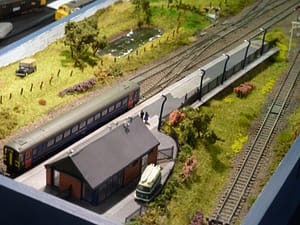

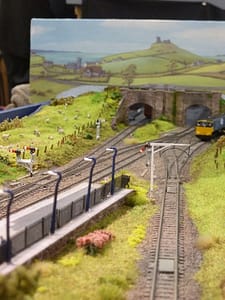
A slice of Poldark country in a box, 1200mm by 300mm. The main station looks to be a modern Regional Railways standard building and the branch leads to a busy dock in the hands of English China Clays. As ever the details like the camper van, ducks, sheep and inevitable seagulls make the scene and in a modern way are timeless from the 1970s onwards.
Poldeen is just off the mainline to Penzance and has a frequent shuttle service and short freights move clay hoods up to the junction. Look out for special traffic like the Inspection saloon, management looking to restart the clotted cream mine traffic of the GWR. MOD traffic and light engines on road learning duties are seen from time to time. Check out Railway modeller No 800 for story of the build.
